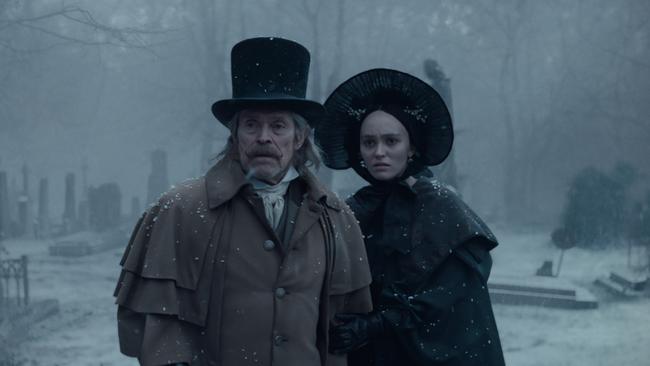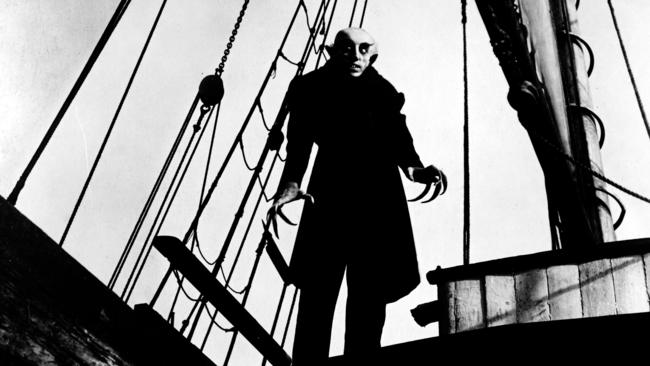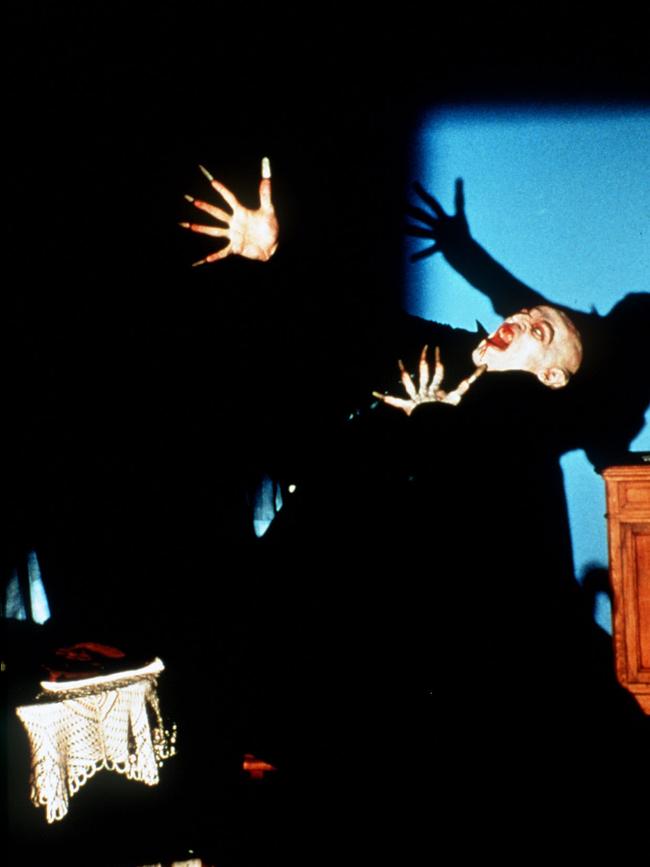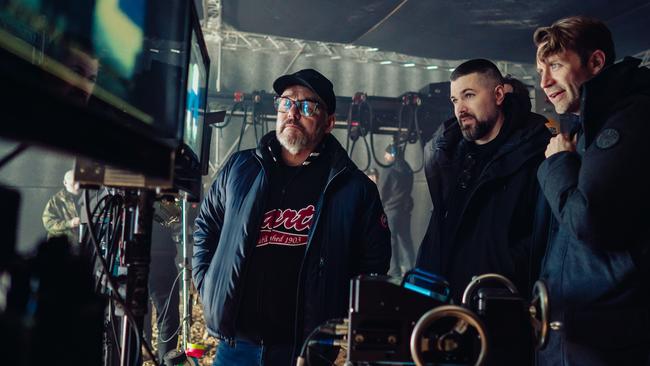Nosferatu: Willem Dafoe and Robert Eggers take on disturbing vampire classic
Willem Dafoe watched his first Robert Eggers film on a whim. Eight years later, the pair are launching their third project together, this time taking on FW Murnau's Nosferatu.

Willem Dafoe saw his first Robert Eggers film on a whim. It was 2016, and he was strolling past the Angelika theatre in New York City when a poster for The Witch, Eggers’ eerie 17th-century New England horror folktale, caught his eye. Intrigued, he decided on a solo movie date. “I entered the world so easily,” Dafoe says. “I was in that movie. I was there with those people. I wasn’t thinking about the story, I wasn’t impatient, and I didn’t think about what stuff meant. I was in it. And I thought, ‘Why is that?’ ”
The Witch moved him. So much so that the next day he dragged his wife to the theatre to see it. Sensing he was on to something special, he contacted Eggers. The two met and quickly agreed to collaborate.
Nosferatu, showing in Australian cinemas on January 1, marks their third film together. It follows 2019’s The Lighthouse, a claustrophobic chamber comedy in which Dafoe starred alongside Robert Pattinson as two mad lighthouse keepers trapped on a remote island in 19th-century Maine.
Then came The Northman in 2022, Egger’s riff on the Norse myth that inspired Hamlet, in which Dafoe made a brief, scene-stealing appearance as a wild-eyed jester.
“I was totally bewildered that Willem wanted to meet with me,” Eggers says. “It’s hard not to sound full of myself, but when we first started talking, even though we were in very different places professionally, it was clear that we spoke the same language and there was a comfortability there.”
The camaraderie between them is unmistakeable, even through the confines of a Zoom call. Eggers, 41, is clean-cut and composed – he could pass for an architect if he didn’t get his kicks crafting gruesome worlds. Dafoe, 69, by contrast, is kinetic – ping-ponging between topics and seemingly ready to leap from his seat at any moment. It’s an odd pairing, but their energies balance beautifully.
Eggers credits Dafoe with reshaping his approach to working with actors. “If it doesn’t feel natural, and like someone I’m working with on a high school play, it’s probably not a good match,” Eggers says, pausing thoughtfully. “The idea of celebrity can overwhelm things.”
Nosferatu is Eggers’ white whale – it took a decade of being knocked back by Hollywood to get the film off the ground. But his love for the original 1922 silent film by FW Murnau goes back much further.

As a nine-year-old self-professed scaredy-cat living in New Hampshire, Eggers convinced his parents to order the film on VHS. It took a month for the tape to arrive, but when it did, it left a lasting mark. The image of Max Schreck’s Count Orlock – bug-eyed, bald, with rotting talons curling around doorframes – lodged itself deep in his imagination.
By high school, Eggers and his friend, theatre director Ashley Kelly-Tata, had staged their own Nosferatu adaptation, a black-and-white silent play complete with teenage actors slathering themselves in greasepaint and supertitles.
Murnau’s Nosferatu, made during the heyday of German expressionist filmmaking, has long been considered the founding – and greatest – vampire flick. Its story is an unauthorised adaptation of Bram Stoker’s Dracula. Stoker’s widow, Florence, famously tried to sue the production company but there was no money left so a Berlin court ruled that every copy of the film should be destroyed.
A handful of prints survived, eventually finding their way to film archives and museums in Germany, France and New York, where preservationists undertook the painstaking task of restoring it, piecing the film together frame by frame.

Both Murnau’s and Eggers’ films follow the same plot beats. In the new version, Nicholas Hoult plays Thomas Hutter, a naive real estate clerk who travels to Transylvania to arrange a property sale for Count Orlock (Bill Skarsgard rocking a moustache similar to that of former Motorhead frontman Lemmy Kilmister), a plague-bringing vampire. After discovering the count’s true nature, Hutter races home to protect his wife, Ellen (a beguiling Lily-Rose Depp), as Orlock follows, wreaking hell in his wake.
Where Murnau’s Nosferatu was steeped in Weimar-era fears and fascinations – Murnau had served in World War I as part of Germany’s Flying Corps, surviving eight plane crashes – Eggers’ take ventures into more primal, psychosexual territory. “I was exploring themes that were already there of sexuality and repression,” Eggers says. “It’s a love triangle, which is more dormant in the Murnau film.”
In Eggers’ film, Ellen is a sleepwalker who is haunted by what can be described only as a horrifying intersection between a wet dream and a sleep paralysis demon. While Eggers avoids catering overtly to modern audiences, he says this version allowed him to “indulge in the things that interest me most instead of having to stick with what interested Bram Stoker”.
This is technically Dafoe’s second spin around the Nosferatu universe. He made for an extraordinary, terrifying Count Orlock in Shadow of the Vampire, director E. Elias Merhige’s 2000 comedy about the making of the 1922 film.

Dafoe, whom Eggers describes as having “the cheekbones of those great horror actors of the 20th century, like Edward Van Sloan and Peter Cushing”, steps into this Nosferatu as Albin Eberhart von Franz, the director’s original creation.
There’s a hint in the name. “He’s a Van Helsing-type character,” Eggers says. “But the Van Helsing of the novel is a little too wholesome for my taste.”
Von Franz is the bridge between the rational and the supernatural, a man at once steeped in the scientific progressivism of the 19th century and the medieval, arcane wisdom of the past. “That’s what makes him the person who can understand Ellen, a woman who doesn’t fit into 19th-century society, and what makes him believe and do something about the vampire that the other characters won’t even accept is around,” Eggers says. The director modelled the character on Albin Grau, the producer and set designer on the original Nosferatu, who was also a member of occult societies, and the Jungian psychologist Marie-Louise von Franz.

In the film, Dafoe delivers this sermon-like monologue, babbling about having witnessed things that would make “Isaac Newtown crawl back into his mother’s womb” and decrying that society has “become so much enlighten as we have been blinded by the gaseous light of science”.
Eggers reveals, somewhat reluctantly, that this speech was added at the studio’s request for more exposition. But it’s one of the film’s most fun moments and is classic Dafoe – nutty and unhinged, like the mad scientist from Yorgos Lanthimos’s 2023 film Poor Things if he were pumped with amphetamines.
Eggers has a reputation for being a freak for research. When writing the dialogue for The Witch, he drew on the diaries of John Winthrop, the first governor of Massachusetts Bay Colony. And for Nosferatu? “It’s technically modern English, the vibe of early Dickens and Austen,” he says. He devoured books from the era and consulted a Victorian thesaurus.
If you thought intimacy co-ordinators were niche, Nosferatu, wrangled in the guidance of a “Romanian-Transylvanian consultant” – the perfectly named Florin Lazarescu. “Orlock’s spells are in ancient Dacian, which is the language of the ancient Romanians. He [Lazarescu] translated my prose into the language, which was cool,” Eggers says, rather nonchalantly.
The director is also notorious for loading his actors up with research – trinkets, backstories, obscure folklore, you name it. Dafoe, who has worked with some of the most notoriously demanding directors in the business – Lars von Trier, Abel Ferrara, Paul Schrader – was game. In fact, he revels in it.
“It’s a great pleasure. It’s an engagement thing that kicks up,” Dafoe says, the words tumbling out.
“It makes it specific, makes you have a stake in it. I’m always struck that when you learn these things, you’re changed. You’re changed!” he bellows. “How you think is changed. You’re taking on new ideas that you didn’t know, and if you welcome that it can open the door to being another person.”

Transformation, for Dafoe, is less a process and more a possession. “It’s an energy. It’s a rhythm that almost creates itself,” he says, sounding a bit like he’s explaining how to summon spirits at a seance. “If you can catch that, it’s a beautiful thing. It lifts you up, it plays on impulses and an imagination that you don’t necessarily own.” He leans in, intensity dialled up a notch: “It works through you … I know that sounds a little spooky, but I believe that.”
Of course, this is Dafoe we’re talking to, a founding member of experimental theatre collective the Wooster Group, whose ethos champions transformation through action, experimentation and dismantling theatrical conventions to allow performances to emerge organically – a little woo-woo is par for the course. “The best situations, the best things, kind of come out effortlessly because the situation makes it natural. It’s not an idea, you know?
“Ideas are so tied to ego and trying to accomplish things, you know? I don’t think in terms of idea, I think in terms of doing,” Dafoe says with a grin. “And then if you’re a great director, they know where to frame it,” he adds, turning to Eggers. “They know how to set you up. They know how to put you in the direction and then let you go like a greyhound.”
Rumours swirl that Dafoe is coaxing Eggers back to the stage for a play together. When asked if there’s any truth to that, they exchange grins. “I would do it, for Willem,” Eggers concedes.
Dafoe beams. “Look at that face. LOOK AT THAT FACE.”
“One of his superpowers as an actor is his ability to just jump in there,” Eggers says, before launching into a story he admits he hasn’t yet told Dafoe.
“One of the best performances of anything I have ever seen in my life was during a press tour for The Lighthouse. We were backstage, and a sea shanty was playing, and Willem starts doing a clockwork dance. He’s beating his chest and he has this nutcracker face on and he’s 125 per cent committed to this 15-second dance.”
Dafoe winks, “And now you know why we work together.”
Nosferatu is in cinemas on January 1.


To join the conversation, please log in. Don't have an account? Register
Join the conversation, you are commenting as Logout